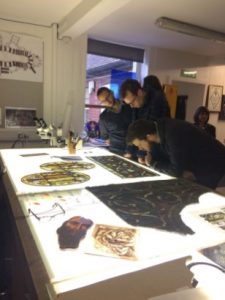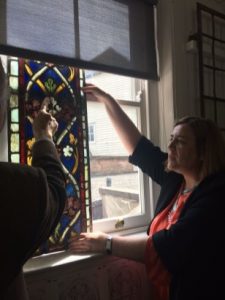by Sophie Kelly (History PhD student) for the Thomas Becket Study Day
There could scarcely be a more appropriate setting for a study day on the theme of Thomas Becket than Canterbury Cathedral, the location of the archbishop’s martyrdom nearly 850 years ago on the 29th December 1170. In the Cathedral Library and Archives, just metres from the site of Becket’s murder in the North West Transept, experts from universities, museums and Canterbury heritage organisations gathered to discuss the saint’s life and cult.
The day began with a series of ‘quick fire’ presentations, each focusing on one theme or object related to Thomas Becket. The range of material gave an immediate sense of the scale and popularity of Becket’s cult in the Middle Ages and beyond. Some objects discussed have likely existed in the vicinity of Canterbury since they were produced, including a fragmentary sandstone ampulla mould discovered in the garden of 16 Watling Street (Dr Paul Bennett, Canterbury Archaeological Trust), a thirteenth-century cartulary made for Christ Church containing charters for the shrine of Thomas Becket (Professor Louise Wilkinson, Canterbury Christ Church University), the seal of Archbishop Simon Sudbury showing Becket’s martyrdom (Dr Sheila Sweetinburgh, University of Kent), and the spectacular miracle windows in the Trinity Chapel of the Cathedral itself (Professor Michael A. Michael, Christie’s Education).
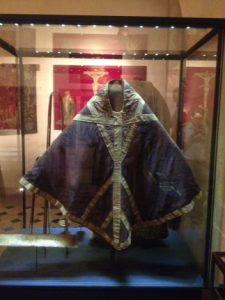
Other delegates discussed geographically dispersed objects which originated or were believed to have originated in Canterbury. For instance, pilgrim souvenirs depicting Becket were bought by visitors to Canterbury and, it would seem, lost on the way home. These badges, with their intricate and compelling imagery, would have been worn on the bags, hats and garments of pilgrims as signs of their visit to Becket’s shrine and are now excavated from sites across Britain and Europe (Amy Jeffs and Dr Gabriel Byng, University of Cambridge and convenors of The Digital Pilgrim Project). Likewise, Dr Emily Guerry (University of Kent) discussed a series of vestments owned by Sens Cathedral that were reputedly worn by Becket and possibly used at Sens as contact relics.
A number of significant objects pertaining to Becket originated from further afield, both geographically and chronologically. Dr Tom Nickson (Courtauld Institute of Art), for example, presented on a c. 1200 altar frontal depicting Becket’s martyrdom found in the church of San Miguel in Almazán, which bears early witness to the popularity of Becket’s cult in Spain.
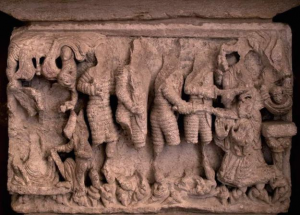
Becket’s later legacy was then examined. Lloyd De Beer (British Museum) assessed the sixteenth-century political and religious connotations of the saint’s martyrdom through the lens of Alberti’s The Martyr’s Picture (1581), displayed in the Venerable English College in Rome, and Naomi Speakman (British Museum) discussed Becket’s memory in post-Reformation England and his representation as an anti-martyr.
These evocative objects and themes provoked a lively concluding discussion that centred on the international nature of Becket’s cult and the extent to which the art associated with it imitated and/or innovated in order promote the saint and potency of his cult as a political tool.
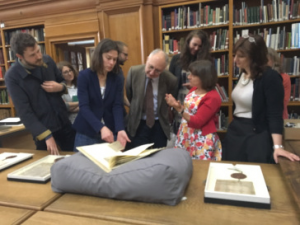
This discussion was followed by an opportunity to see first-hand some of the extraordinary items associated with Becket. Cressida Williams, head of the Cathedral Archives and Library, had organised for an array of Becket-themed documents and objects from the Cathedral collections and various heritage organisations in Canterbury to be displayed together in the reading room of the Cathedral Archives. Among this impressive collection were two fragments of pink Tournai marble, discovered during excavations in the Cathedral grounds, which are thought to have come from the shrine of St Thomas himself. Also on display were a number of medieval seals from the Cathedral’s collections, including those of Archbishops Hubert Walter and Stephen Langton, which both depict Becket’s martyrdom. Dr Helen Gittos from the University of Kent discussed a particular treasure of the Cathedral Archive, the Professions of Obedience, a series of 170 documents now bound into a single volume that record the vows made by bishops during their consecration. These small vellum statements, which would have originally been sewn together in a continuous roll, contain the dates of bishops’ consecrations, and are thus immensely helpful in dating other contemporary documents based on a comparison of their palaeography. Becket’s entry is especially marked in the Professions by a statement in red noting his archiepiscopal status.
The later half of the afternoon saw the group move to the Cathedral stained glass studio, where Leonie Seliger, Head of the Stained Glass Conservation Department, led us in a discussion of the representation of Becket in the Cathedral glass. Notably, only three original thirteenth-century panels depicting Becket’s head survive, which Leonie encouraged us to find among her printed reproductions – a task that proved surprisingly difficult. We also had the opportunity to see some of medieval stained glass currently under restoration in the studio, and to hear from Leonie about the techniques that would have gone in to making these panels. A particular highlight was seeing how the colour of nine hundred year old stained glass was still bright and vivid when held up to the light.
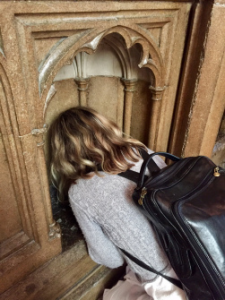
A subsequent tour of the Cathedral offered a chance to see the miracle windows we had discussed in the glass studio in situ, along with the site of Becket’s shrine and several archiepiscopal and royal tombs. The tombs of Archbishops Sudbury and Mepham in the south aisle of the Choir afforded a particularly interactive experience; kneeling down at one of the vaulted prayer niches carved into the tombs’ exterior, penitents (or indeed academics) can experience an amplification not only of the music performed in the nearby Choir, but also their own whispered prayers and thoughts.
Professor Paul Binski (University of Cambridge) brought the study day to a close with a public lecture entitled ‘Thomas Becket and the Medieval Cult of Personality’. Drawing on many of the objects seen and discussed throughout the day, Professor Binski reflected on the idea of Becket’s ‘persona’ (as opposed to the modern notion of ‘personality’) and its importance in the formation and development of his cult. Much like a mask that can be put on or taken off, the medieval concept of an individual’s persona was related to their outer countenance, and formed by certain archetypal characteristics – both good and bad – often rooted in character types in biblical stories or saint’s lives. Becket’s persona and outer image, Professor Binski argued, was imitated in the art and architecture produced in response to his martyrdom, an aspect that was vital to the rapid dissemination and spread of the cult. Due in part to the accessibility of this image through objects made both for the elite and for the ordinary person, Becket’s persona transcended social as well as geographical boundaries, transforming his cult into a widespread, international phenomenon. Professor Binski’s concluding remarks on the appeal of the Becket’s cult in the Middle Ages had a particular resonance amidst of the full lecture theatre where the lasting legacy of Thomas Becket’s life and death was still very much felt.


